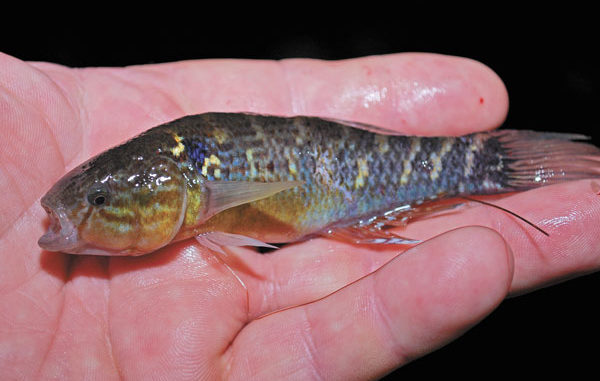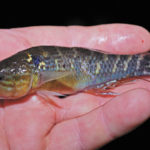
Hurricane Katrina blew this angler to a landlocked state, but that doesn’t keep him from fishing the marshes of Louisiana.
No, I am not talking about a family member or acquaintance. The fat sleeper to which I’m referring is the storm minnow, known to scientists as Dormitator maculatus. Fat sleeper is the “accepted common name” by the American Fisheries Society.
It is also the name, along with jade goby, used by fish keepers for this quite popular aquarium fish. An internet search yields a lot more chatter about the fish in aquaria than about its value as a food or baitfish.
Storm minnows have an almost legendary reputation as an uber-bait, one that will raise speckled trout and redfish from the dead to feed. Fishermen at fishing camps talk of legendary catches made in past falls and winters when they were lucky enough to have a cast net and stumble on a bunch of them schooling at the surface.
These mysterious little fish are year-round residents of coastal Louisiana, where they reside in fresh to low-salinity brackish marshes. At a most casual glance, they may resemble cocaho minnows. They have a similar stumpy body shape and are both less than graceful swimmers.
But they are very different creatures. The storm minnow spends almost its entire life on or in soft mucky bottoms. Storm minnows rest on the bottom on their stiff pelvic fins (the ones under their throat). From that perch, they can dive lighting-quick to grab any food item that comes their way.
And that includes just about anything — living or dead. In the wild, they will eat any creature that will fit into their mouths, which can stretch impressively wide. They also eat dead stuff, both plants and animals, some of it quite decayed. And they eat living plants.
Aquarists are very cautious about keeping it with smaller fish, some of them referring to their pets endearingly as “monsters.” Besides typical dry and frozen fish foods, they have been known to eat tomatoes, bananas and, believe it or not, noodles. I can’t imagine who was the first to think of feeding noodles to a fish, but … .
Spending their time on the bottom also gives them quick access to their primary refuge, the soft mud, debris and detritus of the bottom. When anything threatens them, they quickly dive into the soft bottom.
Fat sleepers are found in coastal waters from the Carolinas, around through the Gulf of Mexico and down to lower Brazil. Most references list them as growing to 1 foot in length, a size that I have never seen in Louisiana. Perhaps they grow larger in the tropics.
In some parts of the country, Asian food stores will carry them in live tanks for sale as food fish. In Alvarado Lagoon, near Veracruz, Mexico, ripe females are stripped of their eggs for human consumption.
Spawning is what makes these interesting little fish available for use as bait by Cajun anglers. After the eggs develop during the late summer and early fall, schools of the fish will suddenly appear on the water’s surface between September and December in what scientists refer to as a nuptial (wedding) parade.
These events seem to be closely correlated with approaching storms, which is where the name “storm minnow” comes from. They seem to appear out of nowhere with storms.
Little is known of their spawning, but it likely does not take place on the surface as part of the nuptial parade, because males have been observed to vigorously guard nests on the bottom. Hatching in aquariums takes place in 11 to 16 hours at 80 degrees. Males mature at about 2 inches long. Females mature at a slightly smaller size. This is about at 1 year of age.
The nuptial parade may have more to do with a catadromous migration than anything else. Catadromous fish live in fresh water, but move to salt water to spawn, the opposite of anadromous fish, such as salmon.
While it is difficult to prove that speckled trout and redfish have a culinary fetish for the little fish, they are excellent baitfish because they are extremely tough. They can live with seemingly no oxygen in the water or even for extended periods of time out of water.
On the hook, they are just as tough. They don’t tear off easily and they don’t die quickly, Often many fish can be caught on one bait before it becomes too tattered to use.
Storm minnows are attractive little fish. They seem to have too many fins for their bodies. The dorsal fin is divided in two, and both sections are large. In males, the second dorsal becomes extended and even larger. Both the tail and anal fins are outsized as well.
Body color is blotchy silver when young, becoming darker as they get older. The maculatus part of the scientific name means “spotted” in Latin and refers to the spotted blotchy color. (Dormitator is also Latin, and means a sleeper, a sluggard or a dreamer.)
Most attractive is the large electric blue blotch located on each side immediately behind the head and above the pectoral fin. This spot, as well as the overall color of the fish becomes darker during spawning season and as the fish grow larger.




